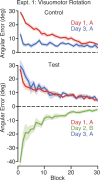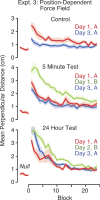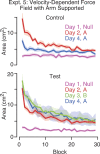Failure to consolidate the consolidation theory of learning for sensorimotor adaptation tasks
- PMID: 15470131
- PMCID: PMC6729970
- DOI: 10.1523/JNEUROSCI.2214-04.2004
Failure to consolidate the consolidation theory of learning for sensorimotor adaptation tasks
Abstract
An influential idea in human motor learning is that there is a consolidation period during which motor memories are transformed from a fragile to a permanent state, no longer susceptible to interference from new learning. The evidence supporting this idea comes from studies showing that the motor memory of a task (A) is lost when an opposing task (B) is experienced soon after, but not if sufficient time is allowed to pass (approximately 6 hr). We report results from three laboratories challenging this consolidation idea. We used an ABA paradigm in the context of a reaching task to assess the influence of experiencing B after A on the retention of A. In two experiments using visuomotor rotations, we found that B fully interferes with the retention of A even when B is experienced 24 hr after A. Contrary to previous reports, in four experiments on learning force fields, we also observed full interference between A and B when they are separated by 24 hr or even 1 week. This latter result holds for both position-dependent and velocity-dependent force fields. For both the visuomotor and force-field tasks, complete interference is still observed when the possible affects of anterograde interference are controlled through the use of washout trials. Our results fail to support the idea that motor memories become consolidated into a protected state. Rather, they are consistent with recent ideas of memory formation, which propose that memories can shift between active and inactive states.
Figures






References
-
- Bock O, Schneider S, Bloomberg J (2001) Conditions for interference versus facilitation during sequential sensorimotor adaptation. Exp Brain Res 138: 359-365. - PubMed
-
- Brashers-Krug T, Shadmehr R, Bizzi E (1996) Consolidation in human motor memory. Nature 382: 252-255. - PubMed
-
- Gomi H, Kawato M (1996) Equilibrium-point control hypothesis examined by measured arm stiffness during multijoint movement. Science 272: 117-120. - PubMed
-
- Goodbody SJ, Wolpert DM (1998) Temporal and amplitude generalization in motor learning. J Neurophysiol 79: 1825-1838. - PubMed
Publication types
MeSH terms
Grants and funding
LinkOut - more resources
Full Text Sources
Other Literature Sources
Medical
